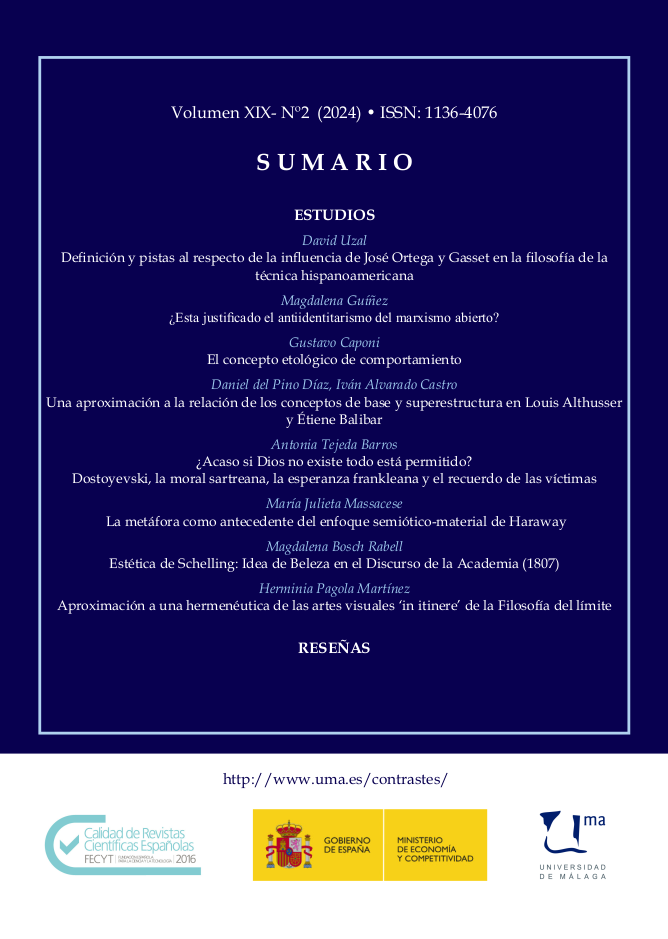Approach to a hermeneutics of the visual arts 'in itinere' from the Philosophy of the limit
DOI:
https://doi.org/10.24310/contrastes.29.2.2024.17573Keywords:
Method, Pattern, Limit, Eugenio Trías, Art 'in itinere'Abstract
Starting from the slogans of contemporary hermeneutics, this text tries to unravel some keys for a hermeneutics of the visual arts in itinere. It analyzes the notions of method (Eugenio Trías), the immanent pattern of action (Upanishads), the affective disposition, the aesthetic-hermeneutic circle and the aesthetic-hermeneutic spiral. Two hypotheses emerge: the questioning about to what extent the paradigmatic and exemplary pattern in a visual art in itinere is proportional to the deployment of the immanent pattern of action of the executing artist; and the defense that the aesthetic merit in these arts implies that in its dynamics the aesthetic-hermeneutic spiral is fulfilled
Downloads
Metrics
Publication Facts
Reviewer profiles N/A
Author statements
Indexed in
-
—
- Academic society
- N/A
- Publisher
- Universidad de Málaga
References
AGUIRRE, J. M. (2015). ¿Conoces a estos filósofos? Estudios de filosofía contemporánea. Madrid: Síntesis.
ARÓSTEGUI, J. (2004). La historia vivida. Sobre la historia del presente. Madrid: Alianza.
BERMEJO, D. (Ed.) (2008). En las fronteras de la ciencia. Barcelona: Anthropos.
BLÄSING, B., PUTTKE, M. Y SCHACK, T. (Eds.) (2010). The Neurocognition of Dance. Mind, Movements and Motors Skills. Psychology Press.
CHAPARRO, J. (2010). El juego como metáfora de libertad y responsabilidad. La ética hermenéutica de Gadamer (Tesis de doctorado). Valencia: Universitat de Valencia. http://hdl.handle.net/10803/52085
CLARK, A. (1997). Being there. Putting brain, body and world together again. Cambridge: The MIT Press.
DROPSY, J. (1987). Vivir en su cuerpo. Expresión corporal y relaciones humanas. Buenos Aires: Paidós.
GADAMER, H.-G. (1981). La razón en la época de la ciencia. Barcelona: Alfa Argentina.
GADAMER, H.-G. (1984). Verdad y Método. Fundamentos de una hermenéutica filosófica. Salamanca: Sígueme.
GADAMER, H.-G. (1991). La actualidad de lo bello. El arte como juego, símbolo y fiesta. Barcelona: Paidós.
GEHM, S., HUSEMANN, P. Y VON WILCKE, K. (Eds.) (2007). Knowledge in Motion: Perspectives of Artistic and Scientific Research in Dance. Bielefeld: Transcript Verlag (German Federal Cultural Foundation).
GOODMAN, N. (2010). Los lenguajes del arte. Madrid: Paidós.
GOODMAN, N. (1998-1999), «Arte y autenticidad», Ensayos. Historia y teoría del arte, 5, pp. 7-24. https://repositorio.unal.edu.co/handle/unal/50772
HEIDEGGER, M. (2003). Ser y tiempo. Madrid: Trotta.
ISLAS, H. (1995). Tecnologías corporales: danza, cuerpo e historia. México: Instituto Nacional de Bellas Artes.
KOSELLECK, R. (2000). Los estratos del tiempo: estudios sobre la historia. Barcelona: Paidós.
MALDINEY, H. (1967), «L’Esthétique des rythmes», Rhuthmos, 27 (2011). https://www.rhuthmos.eu/spip.php?article477
MERLEAU-PONTY, M. (1993). Fenomenología de la percepción. Barcelona: Planeta.
PAGOLA MARTÍNEZ, H. (2016). La danza. ¿Comprensión y comunicación a través del cuerpo en movimiento? Brocar: Cuadernos de investigación histórica, 40, 2016, 269-293.
PAGOLA MARTÍNEZ, H. (2020). El “círculo estético-hermenéutico” en el contexto de la “filosofía del límite”. Definición y aplicación en las artes “in itinere” Brocar: Cuadernos de investigación histórica, 44, 233-254.
PAGOLA MARTÍNEZ, H. (2021). La danza como caso paradigmático del círculo estético-hermenéutico en el contexto de la filosofía del límite
Coreoteca: Un archivo de filosofía de la danza (Victoria Mateos de Manuel), pp. 147-165.
TRÍAS, E. (1995). Filosofía del futuro. Barcelona: Destino.
TRÍAS, E. (1999). La razón fronteriza. Barcelona: Destino.
TRÍAS, E. (2000). Los límites del mundo. Barcelona: Destino.
TRÍAS, E. (2004). El hilo de la verdad. Barcelona: Destino.
TRÍAS, E. (2009). Creaciones filosóficas I. Ética y estética. Barcelona: Galaxia Gutenberg.
VARELA, F. J., THOMPSON, E. Y ROSCH, E. (2005). De cuerpo presente. Las ciencias cognitivas y la experiencia humana. Barcelona: Gedisa.
Downloads
Published
How to Cite
Issue
Section
License
This journal provides immediate free access to its content under the principle of making research freely available to the public. All content published in Contrastes. Revista Internacional de Filosofía, are subject to the Creative Commons Attribution-NonCommercial-ShareAlike 4.0 license whose full text can be found at <http://creativecommons.org/licenses/by-nc-sa/4.0>
It is the responsibility of the authors to obtain the necessary permissions of the images that are subject to copyright.
Authors whose contributions are accepted for publication in this journal will retain the non-exclusive right to use their contributions for academic, research and educational purposes, including self-archiving or repository in open access repositories of any kind.
The electronic edition of this magazine is edited by the Editorial Service of the University of Malaga (Uma Editorial), being necessary to cite the origin in any partial or total reproduction.










5.png)
